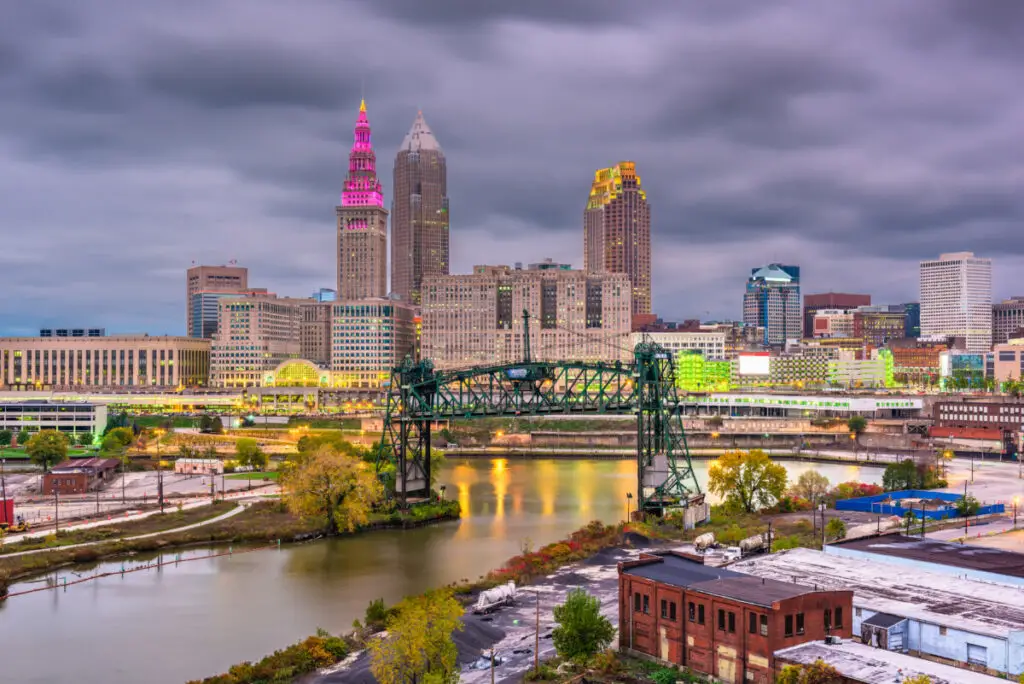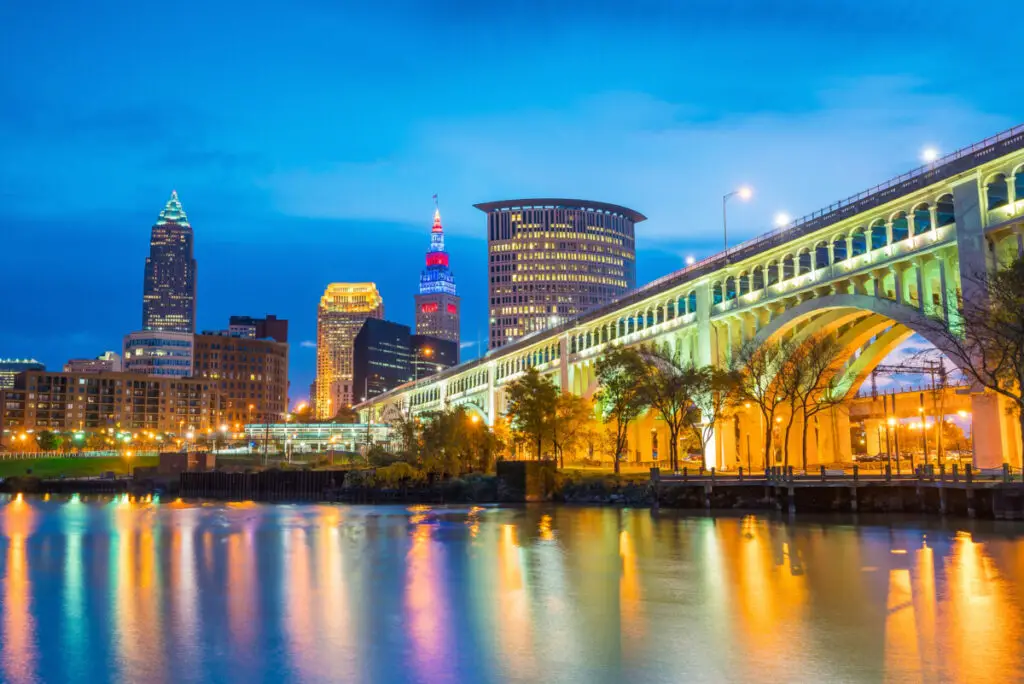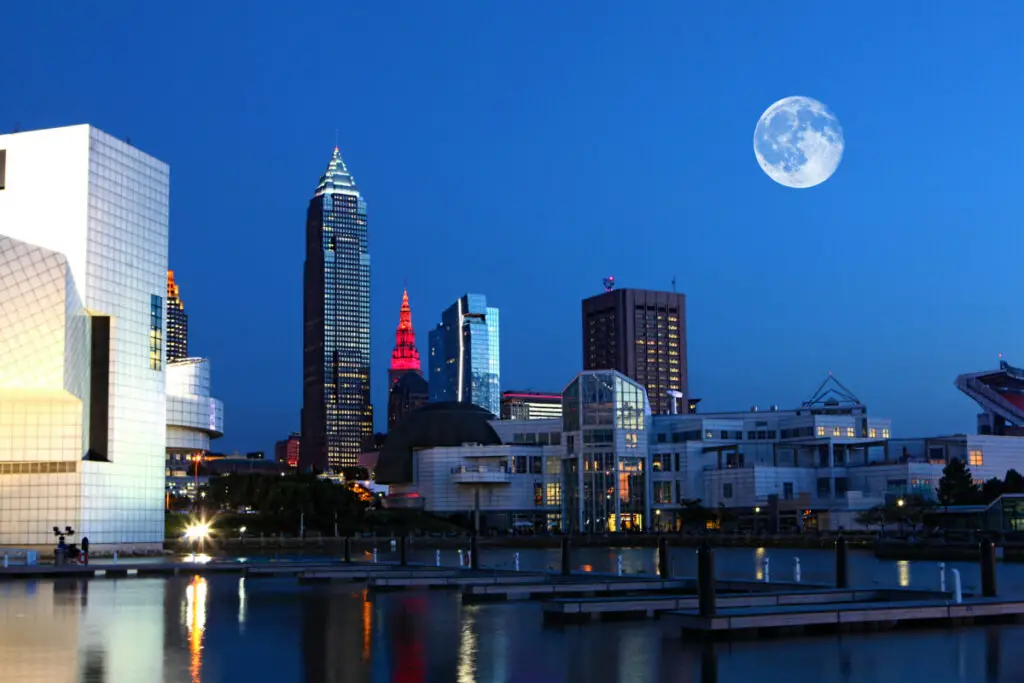
Politics are becoming more and more important these days, and many people want to know that those around them have similar beliefs to those that they have. Is Cleveland, Ohio a more liberal or conservative city?
Cleveland, Ohio is very liberal. The Democratic candidate has won in Cleveland by a wide margin in every presidential election since 2000. Cuyahoga County, Cleveland’s county, is also very liberal, and Ohio is a swing state that leans conservative rather than liberal.
There are many factors to the political climate of a city. When deciding whether Cleveland is liberal or conservative, we need to look at the results of presidential elections, local leaders, policies, and demographics of the city.
Presidential Elections
The results of presidential elections in a city are a big indicator of the political climate of that city. The two major political parties in the United States, the Democratic party and the Republican party, are representative of the liberal and conservative perspectives. The Democratic party has mostly liberal members and supports liberal policies. The Republican party has mostly conservative members and supports conservative policies. If the majority of residents in a city vote for the Democratic candidate, the city is mostly liberal. If most of the residents vote for the Republican candidate, the city is mostly conservative.
It’s important to consider not only the winner of the election but also by how much they won. The difference between the percentage of votes that were Democratic and those that were Republican can show this. If the difference is high, that means that the candidate won by a lot, so there are a lot of people that are liberal or conservative. If the difference is low, then that means that the city is closer to being evenly split.
Ohio is a swing state . Most states can be counted on to vote for either the Democratic or Republican candidate, but swing states can go either way. The final results of the election usually come down to how those states voted. Most swing states tend to lean slightly conservative or liberal, but they can still be swayed given the right circumstances.
. Most states can be counted on to vote for either the Democratic or Republican candidate, but swing states can go either way. The final results of the election usually come down to how those states voted. Most swing states tend to lean slightly conservative or liberal, but they can still be swayed given the right circumstances.
Ohio is a swing state that leans conservative. In the past six presidential elections, Ohio has voted for the Republican candidate in four of them. The differences between the percentages of Democratic and Republican votes were less than 10% in every election. The highest difference was 8.1% in both 2016 and 2020, and the lowest difference was 2.1% in 2004.
In the 2020 presidential election, 53.3% of Ohio residents voted for the Republican candidate, and 45.2% voted for the Democratic candidate. The difference between the percentages was 8.1%, which was the highest difference tied with that in 2016.
Cuyahoga County, the county in which Cleveland is, is very liberal . The Democratic candidate has won over the area in every election since 2000. The difference between the percentages was higher than 30% in every election except the 2000 election. The highest difference was 39.82% in 2012, and the lowest difference was 29.2% in 2000.
. The Democratic candidate has won over the area in every election since 2000. The difference between the percentages was higher than 30% in every election except the 2000 election. The highest difference was 39.82% in 2012, and the lowest difference was 29.2% in 2000.
In the 2020 presidential election, 66.36% of Cuyahoga County residents voted for the Democratic candidate and 32.32% voted for the Republican candidate. The difference between the percentages was 34.04%, which was the third lowest after 2000 and 2004.
Cleveland, like Cuyahoga County and unlike Ohio, is very liberal . The Democratic candidate won in every election since 2000, and the difference between the percentages was higher than 10% in every election. The percentages and differences are comparable to those of Cuyahoga County.
. The Democratic candidate won in every election since 2000, and the difference between the percentages was higher than 10% in every election. The percentages and differences are comparable to those of Cuyahoga County.
From 2018 to 2021, there were 37,498 contributions to the Democratic party in Cleveland. They added up to $8,242,904. In contrast, there were 5,396 contributions to the Republican party, totaling $31,495,641. Though there were over seven times more contributions to the Democratic party, the Republican party brought in almost 4 times more money. This is because the contributions to the Republican party were, on average, 26 times larger than those to the Democratic party.
Local Leaders

The local leaders of a city are representative of the city’s political climate. These are officials that the residents of the city voted to represent based on their political beliefs and promises. Looking at the party affiliations, campaign platforms, and enacted policies of the local leaders of Cleveland can give us an idea of the political beliefs of its residents.
Mayor
The mayor of Cleveland is one of the most important local leaders in Cleveland. The mayor represents the city when dealing with other cities, the state, the country, or internationally. The mayor is responsible for creating a budget, signing the legislation, appointing certain government employees, and overseeing the operations of the city.
The current mayor of Cleveland is Justin Bibb . He was elected in 2022. He won the nonpartisan primary with 27.2% of the vote and the general election with 63% of the vote.
. He was elected in 2022. He won the nonpartisan primary with 27.2% of the vote and the general election with 63% of the vote.
Mayor Bibb has completed or started many initiatives during his time as mayor. Most of these initiatives fall under a few categories of focus: environment, education, equity, culture, neighborhood development, modernizing city hall, and public safety. A few of these include hiring interpreters for city hall, increasing food access programs, and launching a City of Cleveland website.
Though Mayor Bibb is technically considered nonpartisan, he has been known to be affiliated with the Democratic party. This and the focus that he has had while in office support the idea that he has liberal beliefs.
City Council
The Cleveland City Council is in charge of adopting the budget, approving the mayor’s appointees, imposing taxes, and creating or changing laws. The city council has 17 members, each of which is elected by one of the city’s 17 wards.
is in charge of adopting the budget, approving the mayor’s appointees, imposing taxes, and creating or changing laws. The city council has 17 members, each of which is elected by one of the city’s 17 wards.
All the members of the city council are technically nonpartisan, but the initiatives and committees that the city council has taken on are consistent with a majority of liberal opinions.
Policies
The policies that the residents of the city support are another indicator of the political climate of Cleveland, Ohio. Some policies are more likely to be supported or opposed by liberals or conservatives. Fewer abortion regulations, more gun control laws, and legal same-sex marriage are all policies that are more likely to be supported by liberals and opposed by conservatives.
Abortion
Abortions in Ohio must be performed before six weeks of pregnancy unless the mother or fetus’s lives are in danger. Before receiving an abortion, patients must receive state-directed counseling and an ultrasound. Health plans, public funding, and the insurance of public employees cannot cover abortions unless life endangerment, rape, or incest is involved. The parents of a minor must consent before the minor can receive an abortion and abortion clinics must meet specific standards.
must be performed before six weeks of pregnancy unless the mother or fetus’s lives are in danger. Before receiving an abortion, patients must receive state-directed counseling and an ultrasound. Health plans, public funding, and the insurance of public employees cannot cover abortions unless life endangerment, rape, or incest is involved. The parents of a minor must consent before the minor can receive an abortion and abortion clinics must meet specific standards.
In 2017, there were 14 facilities in Ohio that provide abortions, 9 of which were clinics. This was a 25% decline from 2014. 93% of counties did not have clinics providing abortions, which left 55% of Ohio women without access to abortions.
Cleveland residents tend to want a decrease in abortion laws to allow women more access to abortion.
Gun Control Laws
In 2020, Ohio had the 23rd highest gun death rate and the 19th lowest gun export rate. Ohio gun laws include lost/stolen firearm reporting. Ohio gun laws do not include universal background checks, gun owner licensing, domestic violence gun laws, an assault weapon and large capacity magazine ban, waiting periods, concealed and open carry regulations, and child access prevention laws.
lost/stolen firearm reporting. Ohio gun laws do not include universal background checks, gun owner licensing, domestic violence gun laws, an assault weapon and large capacity magazine ban, waiting periods, concealed and open carry regulations, and child access prevention laws.
Cleveland residents tend to want an increase in gun control laws to allow less access to abortion.
Same-Sex Marriage
Same-sex marriage became legal in Ohio on June 26, 2015 . This was when the Supreme Court mandate required all states to legalize same-sex marriage, so it was one of the last states to do so. Cleveland residents supported the legalization of same-sex marriage.
. This was when the Supreme Court mandate required all states to legalize same-sex marriage, so it was one of the last states to do so. Cleveland residents supported the legalization of same-sex marriage.
Demographics

The population of Cleveland is about 378,589 people, and the population density is 4,872 people per square mile. 52.1% of Cleveland residents are female and 47.9% are male. The median age is 35.9, and the average number of people per household is 2.3.
of Cleveland is about 378,589 people, and the population density is 4,872 people per square mile. 52.1% of Cleveland residents are female and 47.9% are male. The median age is 35.9, and the average number of people per household is 2.3.
The racial makeup of Cleveland is as follows:
of Cleveland is as follows:
- White: 33.8%
- Black: 49.8%
- Hispanic/Latino: 11.2%
- Asian: 2.0%
- Native American: 0.2%
- Hawaiian/Pacific Islander: 0.0%
- Two or More Races: 2.8%
- Other: 0.2%
29.0% of Cleveland residents are married and 14.6% are divorced. 15.9% are married with children and 38.5% are single with children.
of Cleveland residents are married and 14.6% are divorced. 15.9% are married with children and 38.5% are single with children.
The average income of a Cleveland resident is $17,436 per year. The median household income is $26,179 per year. The unemployment rate is 6.8%. The sales tax rate is 8.0%, and the income tax rate is 5.5%.
of a Cleveland resident is $17,436 per year. The median household income is $26,179 per year. The unemployment rate is 6.8%. The sales tax rate is 8.0%, and the income tax rate is 5.5%.
79.2% of Cleveland residents are high school graduates, and 22.9% are only high school residents. 10.3% of residents have two-year degrees, 16.4% have four-year degrees, 1.3% have master’s degrees, and 0.6% have professional degrees.
of Cleveland residents are high school graduates, and 22.9% are only high school residents. 10.3% of residents have two-year degrees, 16.4% have four-year degrees, 1.3% have master’s degrees, and 0.6% have professional degrees.
52.2% of Cleveland residents are religious. 48.7% of residents are Christian, 2.4% are Jewish, 0.7% are of eastern faith, and 0.3% are affiliated with Islam.
of Cleveland residents are religious. 48.7% of residents are Christian, 2.4% are Jewish, 0.7% are of eastern faith, and 0.3% are affiliated with Islam.
The rate of violent crime in Cleveland on a scale of 1 to 100 is 72.5. The rate of property crime on the same scale is 74.5. Both are significantly higher than the US average.
in Cleveland on a scale of 1 to 100 is 72.5. The rate of property crime on the same scale is 74.5. Both are significantly higher than the US average.

